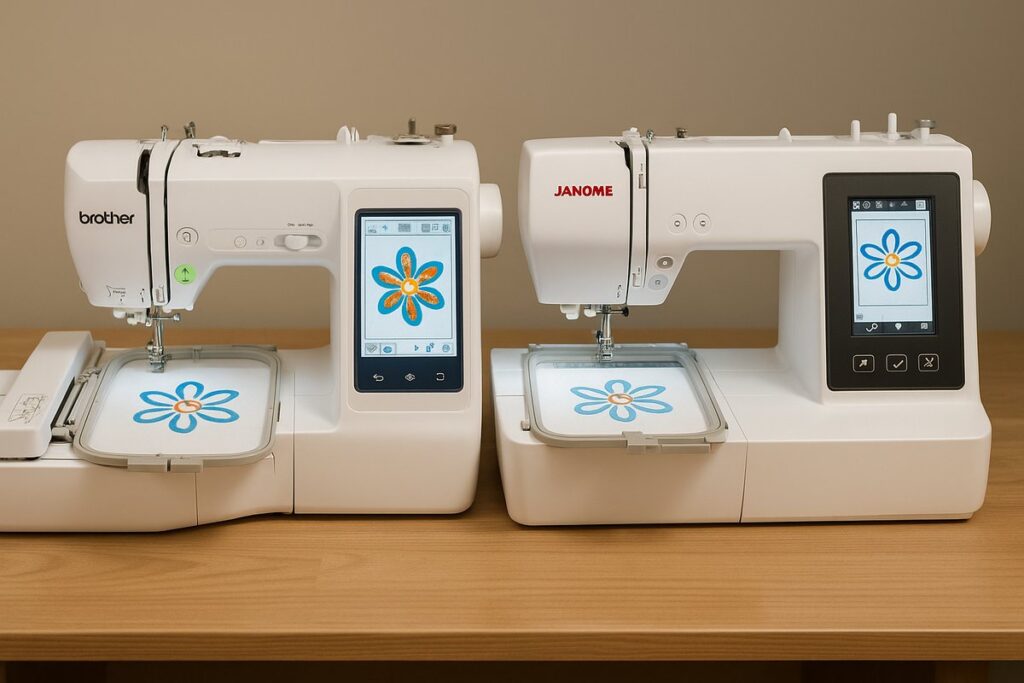
2-in-1 Sewing and Embroidery Machines: The Ultimate Review
Unlock boundless creativity with machines that sew and embroider. Discover the best models for hobbyists and small businesses.
Introduction: The Versatility of 2-in-1 Machines
In the vibrant world of textile arts, the fusion of sewing and embroidery capabilities into a single machine has revolutionized how creators approach their projects. Gone are the days of needing separate, bulky machines for each craft. Today’s 2-in-1 sewing and embroidery machines offer unparalleled versatility, allowing users to seamlessly transition from constructing garments and home décor to embellishing them with intricate designs. These hybrid powerhouses are designed to save space, streamline workflows, and unlock a new dimension of creative possibilities for both casual hobbyists and burgeoning small businesses. This article will guide you through the essential features, compare leading brands, and provide tailored buying advice to help you choose the perfect machine to elevate your craft.
Why Choose a 2-in-1 Sewing and Embroidery Machine?
The decision to invest in a 2-in-1 machine often comes down to efficiency, space, and creative ambition. For many, the primary appeal is the ability to perform two distinct functions with one piece of equipment, reducing clutter in a craft room or home studio. Beyond space-saving, these machines offer a cohesive creative experience. Imagine sewing a custom tote bag and then, with a few adjustments, adding a personalized embroidered monogram or a decorative motif – all on the same machine. This integration fosters a more fluid design process, encouraging experimentation and professional-looking results. They are particularly beneficial for those who enjoy both aspects of textile creation but have limited room or budget for multiple high-end machines. The convenience of not having to transfer projects between different devices also saves valuable time and reduces potential errors.
Key Features to Compare
When evaluating 2-in-1 sewing and embroidery machines, several key features differentiate models and impact their performance and suitability for various projects. Understanding these aspects will help you make an informed decision.
Built-in Stitches and Designs
The number and variety of built-in stitches are crucial for the sewing function. Look for a machine that offers a good range of utility stitches (straight, zigzag, buttonhole) for construction, as well as decorative stitches to add flair to your projects. For embroidery, the quantity and quality of built-in designs are equally important. Some machines come with hundreds of pre-loaded patterns, from alphabets and monograms to intricate floral and geometric motifs. Consider if these designs align with your creative vision, and if the machine allows for easy customization or importing of new designs.
Embroidery Hoops and Area
The size of the embroidery hoop determines the maximum dimensions of the designs you can create. Machines typically come with one or more hoops of varying sizes. A larger embroidery area offers more flexibility for bigger projects, but also means a larger, potentially more expensive machine. Consider the types of projects you plan to undertake. If you envision large back designs for jackets or intricate quilt blocks, a machine with a generous hoop size (e.g., 5×7 inches or larger) is essential. For smaller items like monograms on cuffs or baby clothes, a standard 4×4 inch hoop might suffice.
Software Compatibility and Connectivity
Modern embroidery machines rely heavily on software for design creation, editing, and transfer. Check for compatibility with popular embroidery software (e.g., Embrilliance, Hatch) and the ease of transferring designs to the machine. Common connectivity options include USB ports for flash drives, direct USB connection to a computer, or even Wi-Fi for wireless transfer. User-friendly software that allows for resizing, rotating, combining, and digitizing designs can significantly enhance your embroidery capabilities. Some brands offer their proprietary software, which may integrate seamlessly but could limit third-party options.
Speed and Precision
Sewing and embroidery speed are measured in stitches per minute (SPM). While higher SPM can increase productivity, especially for large projects or small businesses, precision is equally vital. A machine that maintains consistent stitch quality at various speeds is preferable. Look for features like automatic tension adjustment, precise needle positioning, and robust feed dog systems that ensure even fabric feeding. For embroidery, precision ensures that complex designs align perfectly and stitches are dense and even, preventing gaps or puckering.
Ease of Use and Interface
An intuitive interface can make a significant difference in your overall experience. Touchscreens, clear navigation menus, and on-screen tutorials are common features in higher-end models. Automatic needle threaders, quick-set bobbins, and easy stitch selection dials simplify setup and operation. For beginners, a machine with straightforward controls and comprehensive manuals or online support can reduce frustration and accelerate the learning curve. Even experienced users appreciate features that streamline their workflow.
Popular 2-in-1 Models: A Brand Comparison
Let’s explore some of the leading brands and their popular 2-in-1 sewing and embroidery machines, highlighting what makes each stand out.
Brother: User-Friendly Innovation
Brother is a dominant force in the home sewing and embroidery market, renowned for its user-friendly machines that pack a punch in terms of features and innovation. Their 2-in-1 models are particularly popular among hobbyists and small business owners for their intuitive interfaces, extensive built-in designs, and accessible price points. Machines like the **Brother SE600** or **SE700** are often recommended for beginners due to their color LCD touchscreens, automatic needle threaders, and a good selection of sewing stitches and embroidery designs. They typically offer a 4×4 inch embroidery area, which is perfect for monograms and smaller projects. For those needing a larger embroidery field, models like the **Brother PE800** (embroidery-only, but often paired with a Brother sewing machine) or higher-end combo machines provide more expansive options. Brother’s software, such as iBroidery.com, offers a vast library of downloadable designs, and their machines are generally compatible with various embroidery file formats.
Janome: Precision and Advanced Technology
Janome is celebrated for its precision engineering, robust build quality, and pioneering technological advancements in the sewing industry. Their 2-in-1 machines are often favored by serious hobbyists and professionals who demand high-quality stitches and reliable performance. Janome was a pioneer in computerized sewing machines, and this expertise shines through in their combo models. Machines like the **Janome Memory Craft 9850** or **MC 15000** offer a superior sewing experience with a wide array of utility and decorative stitches, coupled with advanced embroidery capabilities. They typically feature larger embroidery areas, faster embroidery speeds, and sophisticated software for design editing directly on the machine or via external programs. Janome machines are known for their smooth operation and ability to handle various fabric types with exceptional accuracy, making them a solid investment for those prioritizing precision and longevity.
Singer: Legacy Meets Modern Functionality
Singer, with its rich history dating back to 1851, continues to be a household name in sewing. Their modern 2-in-1 sewing and embroidery machines blend this legacy of reliability with contemporary features. Singer’s combo machines aim to provide a balance of sewing versatility and embroidery functionality at competitive price points, making them attractive to a broad audience. Models like the **Singer Legacy SE300** or **Futura XL-580** offer a substantial number of built-in stitches and embroidery designs, along with features like automatic needle threaders and large embroidery areas. While perhaps not always as feature-rich as some top-tier Brother or Janome models, Singer machines are known for their straightforward operation and durability, making them a dependable choice for those who appreciate a classic brand with modern capabilities. Their software often provides tools for basic design editing and lettering.
Poolin: Emerging Contender
While not as widely recognized as Brother, Janome, or Singer in the global domestic market, brands like Poolin (or similar emerging brands, often found in specific regional markets or online) are increasingly offering competitive 2-in-1 sewing and embroidery machines. These brands often focus on providing essential features at a more budget-friendly price point, making them an option for beginners or those with limited funds. They might offer a decent selection of stitches and designs, basic embroidery hoop sizes, and USB connectivity. However, it’s crucial to research user reviews and support availability for such brands, as their long-term reliability and software support might vary compared to established leaders. They can be a good entry point for exploring the hobby without a significant initial investment, but buyers should manage expectations regarding advanced features and extensive support networks.
Buying Tips for Hobbyists and Small Business Owners
Choosing the right 2-in-1 machine requires careful consideration of your specific needs and goals.
For Hobbyists: Balancing Features and Budget
As a hobbyist, your primary goal is often creative expression and enjoyment without breaking the bank. Focus on machines that offer a good balance of essential features and a reasonable price. Consider the following:
- **Budget:** Set a realistic budget. Entry-level combo machines can range from $400-$800, while mid-range models can go up to $1500 or more.
- **Ease of Use:** Prioritize machines with intuitive interfaces, automatic features (like needle threaders), and clear instructions to minimize frustration.
- **Built-in Designs:** Ensure the built-in embroidery designs and stitches align with your interests. You don’t need hundreds if you’ll only use a few.
- **Embroidery Area:** A 4×4 inch hoop is often sufficient for most hobbyist projects like monograms, small appliques, and decorative accents.
- **Support:** Look for brands with good customer service and online communities for troubleshooting and inspiration.
Popular choices for hobbyists often include the Brother SE600/SE700 or entry-level Janome Sewist models that offer combo capabilities.
For Small Business Owners: Durability and Production
For small business owners, your machine is an investment in your livelihood. Durability, efficiency, and advanced capabilities are paramount. Consider these factors:
- **Durability and Build Quality:** Invest in a machine with a robust metal frame and high-quality components that can withstand continuous, heavy use.
- **Larger Embroidery Area:** Opt for machines with larger hoop sizes (e.g., 5×7 inches, 6×10 inches, or even larger) to accommodate a wider range of products and designs.
- **Faster Speeds:** Higher sewing and embroidery speeds (SPM) will significantly boost your production efficiency.
- **Advanced Software & Connectivity:** Look for machines with sophisticated software for complex design editing, digitizing, and efficient file transfer (e.g., Wi-Fi). Compatibility with industry-standard file formats is crucial.
- **Reliable Support & Warranty:** Excellent customer service, readily available parts, and a comprehensive warranty are vital for minimizing downtime.
- **Multi-Needle Options:** For serious embroidery businesses, consider upgrading to a multi-needle embroidery machine (though these are typically embroidery-only and not 2-in-1 sewing machines) for increased efficiency and professional results.
Higher-end Brother models (like the DreamMachine series) or Janome Memory Craft machines are often excellent choices for small businesses due to their advanced features and reliability.
Conclusion: Finding Your Perfect Creative Partner
The world of 2-in-1 sewing and embroidery machines offers an exciting blend of functionality and creative freedom. Whether you’re a hobbyist looking to add a personal touch to your projects or a small business owner aiming for professional-grade customization, there’s a machine out there for you. By carefully evaluating features like built-in stitches, embroidery hoop sizes, software compatibility, and ease of use, and by considering your budget and specific project needs, you can confidently select a machine from reputable brands like Brother, Janome, or Singer. Remember, the best machine is one that empowers your creativity, fits your workspace, and helps you bring your textile visions to life. Happy sewing and embroidering!

Leave a Reply